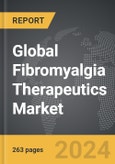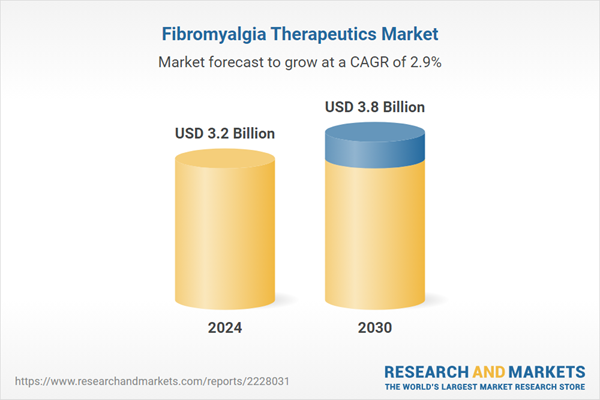Fibromyalgia Therapeutics - Key Trends and Drivers
Fibromyalgia is a chronic condition that significantly impacts the quality of life of about 4 million adults in the United States, primarily affecting women, though not exclusively. It is characterized by widespread musculoskeletal pain accompanied by fatigue, cognitive issues often referred to as 'fibro fog,' sleep disturbances, and heightened sensitivity to stimuli. The diagnosis of fibromyalgia is complex, typically involving a thorough assessment of patient history, symptom checks, and the exclusion of other potential conditions, given there are no definitive tests for fibromyalgia. The condition is often related to genetic factors, with a noticeable prevalence in families, and can be triggered by significant stress or traumatic events. Current understanding and management of fibromyalgia require a broadening of public and professional perception to better support those affected by this debilitating condition.The therapeutic approach to managing fibromyalgia is multifaceted, focusing on alleviating symptoms while addressing the underlying irregularities in pain processing by the central nervous system. FDA-approved medications like pregabalin and duloxetine are commonly prescribed to manage pain and mood symptoms associated with fibromyalgia. Non-steroidal anti-inflammatory drugs (NSAIDs), opioids, and corticosteroids, however, are generally ineffective. Other treatments include gabapentinoids for nerve pain, sedatives for sleep disturbances, and SNRIs and SSRIs for managing psychological symptoms. Non-pharmacological treatments such as physical therapy, acupuncture, cognitive behavioral therapy, and lifestyle modifications like dietary changes are also essential components of a comprehensive treatment plan. These strategies aim to improve overall physical function, reduce pain, and enhance quality of life for fibromyalgia patients.
The growth in fibromyalgia therapeutics is driven by several key factors. Advancements in diagnostic technologies have improved the accuracy and timeliness of fibromyalgia diagnosis, enhancing the application of targeted treatments. The integration of AI and machine learning in healthcare facilitates personalized treatment plans, optimizing therapy outcomes. Wearable health technology that monitors vital health metrics has become instrumental in customizing treatment approaches based on real-time data. Additionally, increased availability of telemedicine services has expanded access to care, particularly for patients in remote areas, improving adherence to treatment regimens. There is also a notable shift towards non-pharmacological treatments, reflecting a growing patient preference for alternative therapies. Furthermore, educational initiatives and increased awareness are crucial in promoting early diagnosis and effective management of fibromyalgia. Regulatory support and favorable reimbursement policies also play significant roles in encouraging the adoption of innovative therapies, making treatments more accessible and affordable. Collectively, these factors are shaping a more dynamic, integrated, and patient-centric landscape in fibromyalgia therapeutics.
Report Scope
The report analyzes the Fibromyalgia Therapeutics market, presented in terms of market value. The analysis covers the key segments and geographic regions outlined below.- Segments: Drug Class (Antiepileptics, Antidepressants, Other Drug Classes).
- Geographic Regions/Countries: World; United States; Canada; Japan; China; Europe (France; Germany; Italy; United Kingdom; Spain; Russia; and Rest of Europe); Asia-Pacific (Australia; India; South Korea; and Rest of Asia-Pacific); Latin America (Argentina; Brazil; Mexico; and Rest of Latin America); Middle East (Iran; Israel; Saudi Arabia; United Arab Emirates; and Rest of Middle East); and Africa.
Key Insights:
- Market Growth: Understand the significant growth trajectory of the Antiepileptics segment, which is expected to reach US$2.1 Billion by 2030 with a CAGR of a 2.8%. The Antidepressants segment is also set to grow at 3.4% CAGR over the analysis period.
- Regional Analysis: Gain insights into the U.S. market, valued at $851.8 Million in 2024, and China, forecasted to grow at an impressive 4.9% CAGR to reach $736.2 Million by 2030. Discover growth trends in other key regions, including Japan, Canada, Germany, and the Asia-Pacific.
Why You Should Buy This Report:
- Detailed Market Analysis: Access a thorough analysis of the Global Fibromyalgia Therapeutics Market, covering all major geographic regions and market segments.
- Competitive Insights: Get an overview of the competitive landscape, including the market presence of major players across different geographies.
- Future Trends and Drivers: Understand the key trends and drivers shaping the future of the Global Fibromyalgia Therapeutics Market.
- Actionable Insights: Benefit from actionable insights that can help you identify new revenue opportunities and make strategic business decisions.
Key Questions Answered:
- How is the Global Fibromyalgia Therapeutics Market expected to evolve by 2030?
- What are the main drivers and restraints affecting the market?
- Which market segments will grow the most over the forecast period?
- How will market shares for different regions and segments change by 2030?
- Who are the leading players in the market, and what are their prospects?
Report Features:
- Comprehensive Market Data: Independent analysis of annual sales and market forecasts in US$ Million from 2024 to 2030.
- In-Depth Regional Analysis: Detailed insights into key markets, including the U.S., China, Japan, Canada, Europe, Asia-Pacific, Latin America, Middle East, and Africa.
- Company Profiles: Coverage of players such as ALCOR Scientific Inc., Amsino International Inc., Applied Medical Technology Inc., B. Braun Melsungen AG, Boston Scientific Corporation and more.
- Complimentary Updates: Receive free report updates for one year to keep you informed of the latest market developments.
Some of the 22 companies featured in this Fibromyalgia Therapeutics market report include:
- Allergan plc
- Boehringer Ingelheim GmbH
- Daiichi Sankyo Company Limited
- Eli Lilly and Company
- Innovative Med Concepts Inc.
- Pfizer Inc.
- SWITCHBIOTECH LLC
- Zynerba Pharmaceuticals Inc.
This edition integrates the latest global trade and economic shifts into comprehensive market analysis. Key updates include:
- Tariff and Trade Impact: Insights into global tariff negotiations across 180+ countries, with analysis of supply chain turbulence, sourcing disruptions, and geographic realignment. Special focus on 2025 as a pivotal year for trade tensions, including updated perspectives on the Trump-era tariffs.
- Adjusted Forecasts and Analytics: Revised global and regional market forecasts through 2030, incorporating tariff effects, economic uncertainty, and structural changes in globalization. Includes historical analysis from 2015 to 2023.
- Strategic Market Dynamics: Evaluation of revised market prospects, regional outlooks, and key economic indicators such as population and urbanization trends.
- Innovation & Technology Trends: Latest developments in product and process innovation, emerging technologies, and key industry drivers shaping the competitive landscape.
- Competitive Intelligence: Updated global market share estimates for 2025, competitive positioning of major players (Strong/Active/Niche/Trivial), and refined focus on leading global brands and core players.
- Expert Insight & Commentary: Strategic analysis from economists, trade experts, and domain specialists to contextualize market shifts and identify emerging opportunities.
Table of Contents
Companies Mentioned (Partial List)
A selection of companies mentioned in this report includes, but is not limited to:
- Allergan plc
- Boehringer Ingelheim GmbH
- Daiichi Sankyo Company Limited
- Eli Lilly and Company
- Innovative Med Concepts Inc.
- Pfizer Inc.
- SWITCHBIOTECH LLC
- Zynerba Pharmaceuticals Inc.
Table Information
| Report Attribute | Details |
|---|---|
| No. of Pages | 263 |
| Published | December 2025 |
| Forecast Period | 2024 - 2030 |
| Estimated Market Value ( USD | $ 3.2 Billion |
| Forecasted Market Value ( USD | $ 3.8 Billion |
| Compound Annual Growth Rate | 2.9% |
| Regions Covered | Global |









